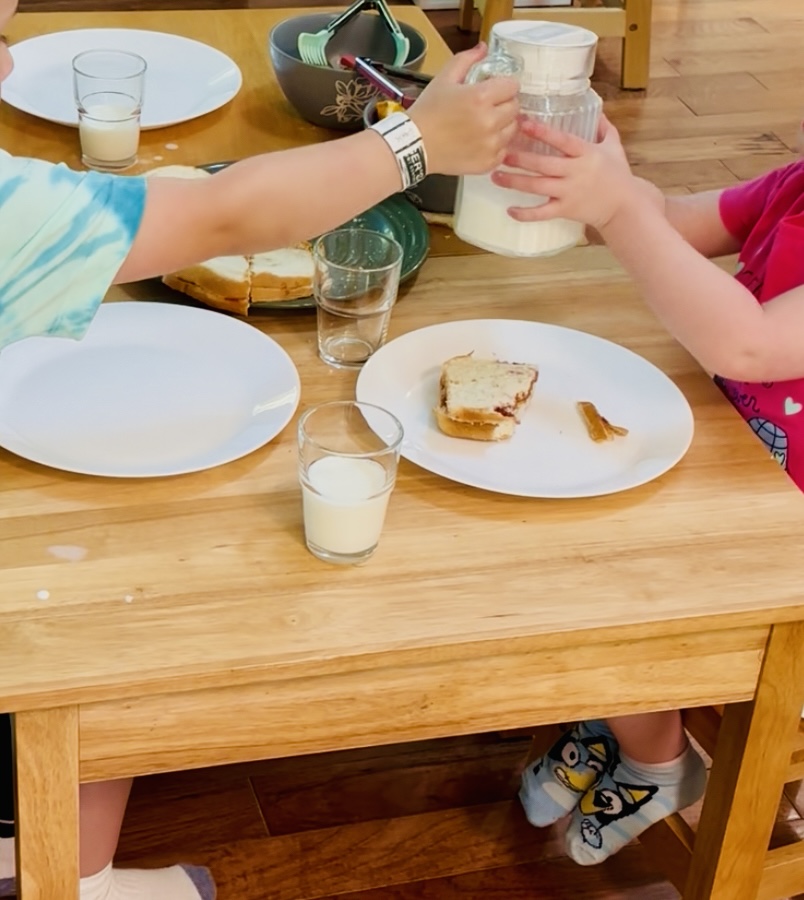
If you’ve ever felt torn between wanting your child to help at mealtime and dreading the mess it might cause, you’re not alone. Many of us—myself included—have stood in the kitchen thinking, “Is this really worth it?” But here’s what I’ve learned, both in the Montessori classroom and in my own home: inviting your child into the process isn’t just “worth it,” it’s transformative.
Montessori encourages us to see mealtime not just as a moment to feed our children, but as a rich opportunity for them to build independence, coordination, and confidence. When we offer the right tools—tools that fit their small hands and support real involvement—we begin to see that shift. The spills become fewer, the pride becomes greater, and the family table becomes a place of connection.
Here are five of my favorite Montessori-inspired tools to help your child build confidence at mealtime—starting today.
Imagine trying to peel a carrot with a tool twice the size of your hand. That’s exactly what it feels like for toddlers using adult-sized kitchen gear. Montessori recognizes that children thrive when they have real tools, thoughtfully sized for them.
A set of child-safe food prep tools—like a crinkle cutter, peeler, or spreader—is perfect for little hands eager to help. These aren’t toys; they’re real tools designed to do real work safely.
🎯 At Home Tip: Invite your child to help prep snack foods—slicing bananas, peeling boiled eggs, or spreading nut butter on toast. Even toddlers as young as 18 months can participate with supervision!
🛍️ Try This: Our Montessori Food Prep Kits includes beautifully crafted, child-sized tools that build real skills and foster independence—without the overwhelm. It’s everything your child needs to get started in the kitchen, plus a detailed guide for you.
There’s something deeply satisfying about pouring your own drink. With the right tools, even very young children can master this skill. A small glass pitcher (ideally clear and holding about 4–8 oz) encourages hand-eye coordination, control, and independence.
In the classroom, we start with dry pouring (rice, lentils) and then graduate to water. At home, I started keeping a small pitcher with water on a low shelf so my toddler could serve herself during snack time—and she absolutely lit up with pride!
🎯 At Home Tip: Use water-dyed with a drop of food coloring when practicing—it helps children visually track the pour, and adds a little extra joy to the experience.
Children thrive on routine, and visuals make expectations clear. When my daughter was two, I noticed how much smoother our mealtimes became when she knew what was coming next. That’s exactly why we created our Mealtime Routine Cards.
These simple, step-by-step visual guides empower children to move through the mealtime rhythm with confidence—washing hands, setting the table, eating, clearing their dishes, and more. They’re especially helpful for toddlers and preschoolers who are still learning to sequence events.
🎯 At Home Tip: Use a small stand or magnetic board in your kitchen to display the cards. Let your child turn each one over as they complete the step—it turns routine into an empowering ritual.
You can download the cards for FREE! Just complete the form below for your instant download:
When children use plates and bowls that match their size and motor skills, they are more likely to succeed—and less likely to spill or feel frustrated. Montessori environments typically offer ceramic or tempered glass dishware (yes, even for toddlers!). Why? Because real materials communicate trust and respect.
When we invite children to use “real” things, they rise to the occasion.
🎯 At Home Tip: Start with a small plate and open cup—skip the sippy cup when possible, and use a training glass with just a bit of water to start. Accidents happen, but with practice, confidence builds quickly.
🛍️ Try This: Our Meal Kit includes child sized plates, utensils, and even cloth napkins, making it easy to bring beauty and function to your child’s table.
This one isn’t a “tool” in the traditional sense, but it’s essential. Whether it’s a low weaning table for toddlers or a sturdy footrest at your family table, giving children physical stability during meals makes all the difference. It allows their bodies to feel grounded and their hands to move freely.
Children who can sit securely—feet flat, knees bent at 90 degrees—are much more capable of focusing on the skills at hand, whether it’s scooping, cutting, or simply eating with utensils.
🎯 At Home Tip: A booster seat with a footrest or a child-sized table and chairs encourages independence without the need to be lifted into a high chair. It also communicates that your child is a participant in mealtime, not a passive observer.
When we offer children real tools and the space to try, we’re saying, “I believe in you.” Yes, there will be spills. Yes, it might be slower than doing it ourselves. But the pride in their eyes—the joy of “I did it!”—makes it all worth it.
Montessori mealtimes aren’t about perfection. They’re about presence, practice, and partnership. With a few thoughtful tools and a little patience, your child can begin to build not just coordination, but true confidence.
This post may contain affiliate links. That means I may earn a small commission—at no extra cost to you—if you choose to make a purchase through one of these links. I only recommend products I genuinely love and use in my own Montessori-inspired home or classroom. Thank you for supporting this blog and helping me share Montessori with more families!
Copyright © 2024-2025 The Montessori Studio | Site Crafted by Felicity Creative
Notifications